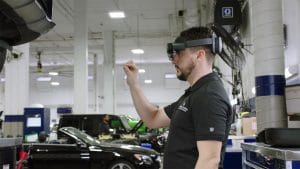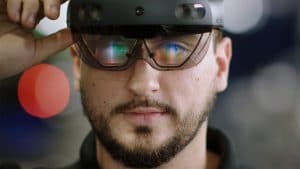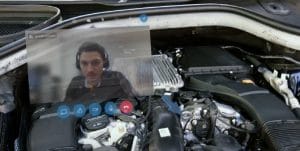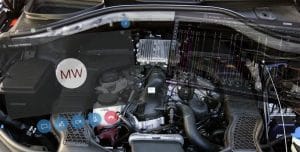Mercedes-Benz is teaming up with Microsoft to create what it is called a “mixed reality automotive maintenance system” to change the way repair shop mechanics work, especially when they might run into a problem requiring assistance from the factory.
The Mercedes-Benz Virtual Remote Support system will let mechanics share real-time images, as well as sounds with technical specialists back at the factory who could help solve a sticky problem. In the process, the automaker said while announcing the new system, problems will be addressed more rapidly and with less likelihood a customer might have to return to the service shop again.
“It’s like having an expert on your shoulder,” said Christian Treiber, vice president of Customer Services at Mercedes-Benz USA. “This is a massive shift in the way we do business – helping us to serve our customers more quickly – and is especially timely with the new realities of COVID-19 and our desire to keep employees safe.”
(Mercedes keeps the sedan faith, reveals pricing for 2021 E-Class makeover.)

The system allows the mechanic to work together with a factory specialist to address particularly troublesome repair problems.
Automakers, in general, have been trying to improve the service experience which is closely linked to owner loyalty – which in turn translates into the likelihood an owner will return to the brand when it’s time to trade in.
That’s a difficult challenge, especially in an era when vehicles are becoming increasingly complex. Research by J.D. Power, among others, finds that traditional mechanical issues, such as engine and transmission failures, have become less and less common. But problems with high-tech systems have become naggingly familiar, no surprise, said Treiber, considering the typical new model can rely on more than 100 million lines of software code.
“Through our partnership with Microsoft,” he said, “we have a new paradigm for technology support and communication that helps our dealers and technicians master the complexity of these vehicles while eliminating travel time and onsite visits.”
Like other manufacturers, the newest Mercedes models – such as the new S-Class sedan coming to market next year – will feature the capacity for smartphone-style over-the-air, or OTA, updates. That will allow direct factory tweaks of software that may be causing problems, as well as upgrades to onboard features.
(First look, 2021 Mercedes-Benz S-Class.)
But not all issues can be solved by a download. There will be times when a vehicle will still require a visit back to the dealer for repairs. In some instances, these prove to be particularly problematic issues where a service technician could use a bit of help. Mercedes has a team of specialists including 24 field techs who fly around the country to dealerships needing a hand.
But “they can’t be everywhere at same time,” he points out, not when handling more than 500 dealerships. So, “with this technology we can be there within minutes,” at least in virtual form. As a result, “We can now solve problems in minutes and hours, rather than days.”
To make use of Virtual Remote Support, the onsite mechanic puts on a Microsoft HoloLens 2 headset which provides access to the Dynamics 365 Remote Assist system. In turn, a remote specialist can see and hear precisely what the mechanic is experiencing.
Beyond that, the headset lets both of them see 3D images, holograms, documents and diagrams. The remote technician can annotate what the mechanic sees, inserting an arrow, for example, to point to the source of a problem.
“We save so much time not having to go back and forth, uploading information, asking questions, waiting for a response.” said Matias Scolnik, the shop foreman at Mercedes-Benz of Coral Gables, one of 13 dealerships that piloted the new repair technology. “To get cars back to the owners—diagnosed, fixed, washed and ready to roll—in a fraction of the time, this has a huge impact on our ability to provide excellent customer service.”
With today’s official unveiling, Mercedes now plans to roll out the Virtual Remote Support system to all 383 of its U.S. dealers. The system will cost each dealer about $10,000, according to Treiber, adding that about 500 technicians across the country have now been trained to use the technology.
The new technology won’t be limited to Mercedes-Benz. Microsoft has plans to use similar systems in a variety of different areas, said Andrew Saunders, who worked with the German automaker on the development of its Virtual Remote Support system. “We are at the dawn of the age where we can literally extend our senses in three dimensions over a network.”
(Mercedes offers look at pre-production AMG-powered SL model.)




I guess Mercedes couldn’t find a good SW company to work with.